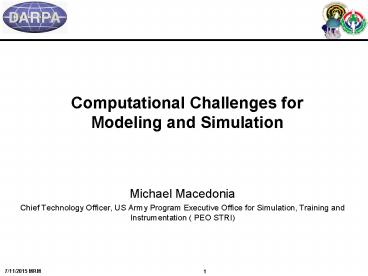Computational Challenges for Modeling and Simulation PowerPoint PPT Presentation
Title: Computational Challenges for Modeling and Simulation
1
Computational Challenges for Modeling and
Simulation
- Michael Macedonia
- Chief Technology Officer, US Army Program
Executive Office for Simulation, Training and
Instrumentation ( PEO STRI)
2
Real-time Computational Challenges for Computer
Generated Forces (CGF)
- Need to provide interactive, real-time terrain
reasoning for Computer Generated Forces given - Extremely dense terrain databases (e.g. Baku,
NYC, Baghdad) - Thousand of simulated entities (size of Army Unit
of Action) - Simulation of long-range and novel sensors
- Must fit on Future Combat System platforms (no
Beowulf clusters allowed)
Bottomline Traditional CPU architecture and
Moores law are not enough to achieve capability
in this decade.
3
Real-time Terrain Algorithms for Computer
Generated Forces
- Best algorithms are O(N2 ) where N
objects/entities in the CGF database (e.g.,
sensors, platforms, buildings, people) - 40 to 80 of CGF CPU time is required for
battalion-level scenarios spent in sensing
functions - Collision detection
- Line of sight computation
4
Purpose of LOS Algorithms
- Simulated LOS for Models and Simulations
- Position Sensors to Maximum Visibility
- Position Targets to Minimize Visibility
- Basically, we need to answer the question
- Can a sensor at location A see a Target at
- location B?
Courtesy Danny Champion, TRAC
5
Algorithm Considerations
- Coordinate System (UTM or Lat/Long or
Geocentric)? - Curved or Flat Earth or Radar LOS?
- How is sensor/target elevations determined?
- How are features (vegetation/urban) treated?
- How is LOS blocked? (slope or calculated
elevation) - Terrain Resolution and its effects on LOS
- Lower Resolution faster, less accurate
- Higher Resolution slower, more accurate
- How should the algorithm be implemented?
- Which algorithms work best with my hardware?
- Precision, Precision, Precision
Courtesy Danny Champion, TRAC
6
Triangular Irregular Network
7
Current Army Visibility Products
Source Doug Caldwell Topographic Engineering
Center
8
TIREM Propagation Model
9
A Familiar Curve
TRAC WSR LOS Study 1995
10
A Pathological Example
11
Real World Example Falling Performance of CCTT
CGF
12
Why GPU/Streaming ?
Source Anselmo Lastra
PowerShow.com is a leading presentation sharing website. It has millions of presentations already uploaded and available with 1,000s more being uploaded by its users every day. Whatever your area of interest, here you’ll be able to find and view presentations you’ll love and possibly download. And, best of all, it is completely free and easy to use.
You might even have a presentation you’d like to share with others. If so, just upload it to PowerShow.com. We’ll convert it to an HTML5 slideshow that includes all the media types you’ve already added: audio, video, music, pictures, animations and transition effects. Then you can share it with your target audience as well as PowerShow.com’s millions of monthly visitors. And, again, it’s all free.
About the Developers
PowerShow.com is brought to you by CrystalGraphics, the award-winning developer and market-leading publisher of rich-media enhancement products for presentations. Our product offerings include millions of PowerPoint templates, diagrams, animated 3D characters and more.

